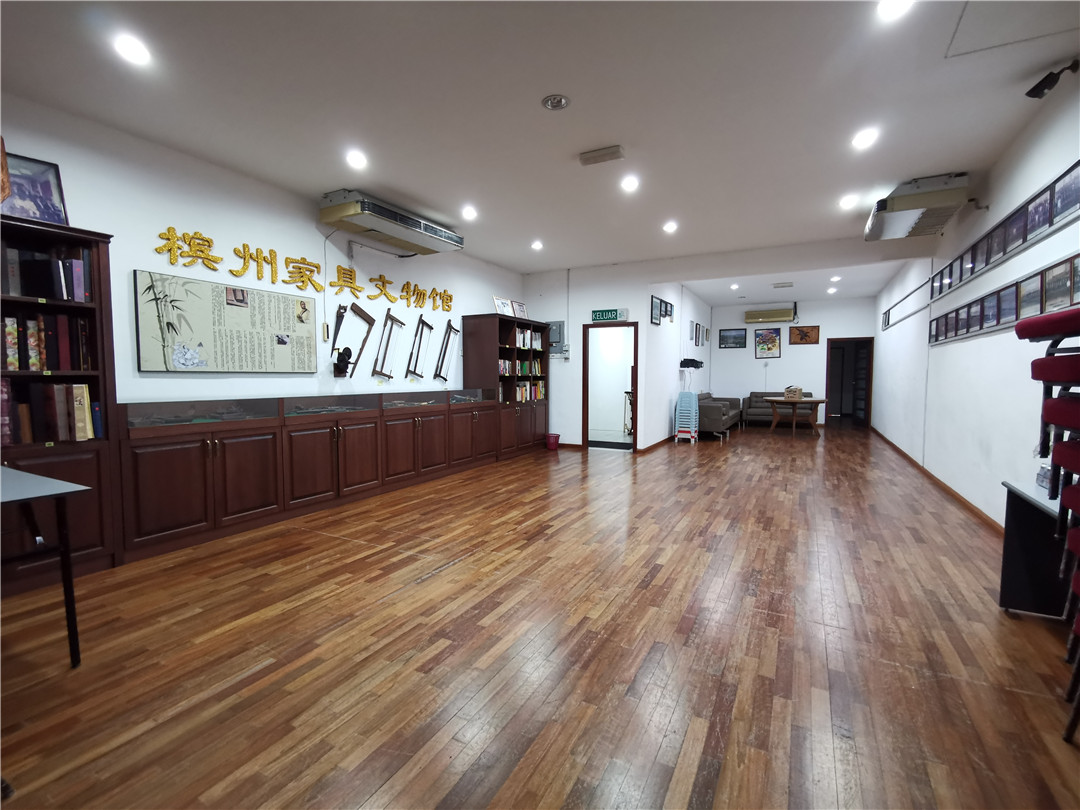About Us
Furniture Cultural Museum
(The Traditional Carpenter’s Tool Collection)
Furniture Cultural Museum
(The Traditional Carpenter’s Tool Collection)
槟州家具文物馆
(传统家具工具收藏品)


It was the year 1985. The downturn in the global economy affected all countries, including Malaysia. Housing developments were abandoned, strikes become commonplace and unemployment was rampant. Businesses were barely surviving, and many had to close their doors for the last time. The furniture industry was one of many that had to bear the brunt of the sinking economy.
As the saying goes, when there is a will, there is a way. A few determined furniture manufacturers got together and decided to change their fate. They knew just waiting for business opportunities locally will not suffice. Venturing into international market may open up new possibilities for success.
A year later, in 1986, the government introduced the industrial blueprint to jumpstart the flagging economy. In tandem with the implementation of the industrial blueprint, the Furniture Association was intensively encouraging its members to broaden their horizons by visiting overseas furniture manufacturing exhibitions. Visits to these exhibitions not only exposed its members to unexplored potential within the industry, but also enabled its members to gain knowledge and expertise to move forward into an automated manufacturing era.
By the year 1990, the local furniture industry was ready to penetrate the international market. The Muar Furniture Association (MFA) got the ball rolling by successfully organising several exhibitions such as the 1990 Furniture Exposition for its members to gain international exposure and recognition. The investments in new manufacturing techniques and automated machinery gradually paid off as orders started pouring in from the overseas market, contributing considerably to the nation’s economy.
This furniture manufacturing revolution from the traditional method to mass manufacturing also marked the end of the traditional furniture making apprenticeship and the disappearance of the traditional carpenter’s tools.
Due to the demands of high volume furniture production, traditional hand tools were replaced by efficient and high speed machinery. The traditional wood working tools such as the Guang Dong Wood Frame Saw, Auger and Brace, Straight Line Marker and various Planers slowly faded into obscurity. Although these traditional tools were not designed for mass production capacity, they were incredibly innovative inventions that were effective and precise. Therefore, three years ago, we took it upon our Association to preserve these Penang furniture cultural relics for our future generations before these traditional tools completely disappear.
As of now, we have a collection of 98 traditional carpenter’s items comprising Wood Saw, Guang Dong Wood Frame Saw, Planer, Auger, Lu-Ban Ruler, Plumb Bob, Straight Line Marker, Gauge, Manual Grinding Machine, Chisel, Axe, Mallet and many other relics. We are on the lookout for more items such as the Beam Compass to add to our Association’s collection and save these traditional woodworking items from vanishing for eternity. We would like to take this opportunity to appeal to more members not only from the furniture industry, but also other industries to come forward and contribute more items towards this worthy cause of preserving our cultural heritage before it is too late.
In addition to our array of traditional carpenter’s tools, we also provide a collection of publications and literature related to the furniture industry such as Furniture Literary, Business Law Management, Marketing, the environment, Advertising, Design and also on Buddhism.
If you are a connoisseur of fine arts and crafts, and celebrate innovation and creativity, we would like to recommend The Illustrated Classic of Master Ban of Lu State and the Legend of Lu Ban for your perusal and reading pleasure. The Illustrated Classic of Master Ban of Lu State, written in the year 1606, among other building subjects, talks about various aspects on carpentry and building for harmonious energy flow and wealth creation. The Legend of Lu Ban is a publication that is rich in abstract content that requires deep analytical thinking, and is a perfect companion for contemplation and unraveling the mysteries of life.
濒临消失的家具古老工具
1985年世界经济不景气,马来西亚也受到波及,经济低迷造成屋业下跌,百业萧条,失业率增长。家具业在这经济低迷时期,也惨淡经营及有一些甚至倒闭。“穷则变、变则通”。一些具有远见的厂家,即把触角伸向海外寻求新的商机。
1986年政府为了提升经济成长,推出了大马第一个工业大蓝图,提供优惠条件,刺激工商经济的复苏。另一方面,商会也积极地带领会员到国外参加木工机械展览会,使会员们吸取足够的知识,以走向机械化制造家具的时代。
1990年家具业为了寻求更大的商机及开拓更广阔的国际市场,麻坡家具商会主办了“麻坡家具展”成功地带领我国家具同业“跨出国门,走向世界”。这是家具业发展的一个重要的里程碑。出口家具主要是以大量生产的方式进行,这推动了家具自动化制造的发展与改革,这一次的改革对家具业产生了二个很重大的影响。一、师徒制 度的瓦解,二、传统古老工具的消失。
传统古老工具的消失
由于出口家具都是以大量生产方式进行,并且都以机械化来代替人手操作,这无形中就淘汰了一些古老传统工具,就如广东木框锯、手钻、墨斗、各种各样的刨等等。古老工具是前贤为提升工匠操作效率的一个很有智慧的创造,由于时代的发展眼看这些古老工具一件件退出舞台与消失,本会觉得有这个责任要在这些古老工具未消 失之前,把它们收集起来,以让后代了解家具工业的发展过程。有鉴于此,本会在三年前即开始策划成立这间文物馆。
目前,本会所收集 到古老工具有98件,这些工具包括:锯、广东木框锯、刨、钻、鲁班尺、吊槌、墨斗、平水尺、手动磨砺机、凿、锛、斧、勒子等等。同时本会希望还能收集更多的濒临消失的传统家具工具如圆规等等。所以敬希会员们或是同业能乐意献捐更多传统的家具工具给本会收藏。
文物馆除了收藏古老工具以外,它也收藏了有关家具业与文学的文献,其中包括:家具专业著作、商业法律管理学、销售、环保、广告、品牌、设计、文学、佛教、杂志与特刊等等。
在此,本会推荐两本书籍,第一本是《鲁班经》,另外一本是《鲁班传奇》。《鲁班经》系明朝万历丙午年(1606年)刻本,此书由鲁班造福经、择日全纪和秘诀仙机三种经典合成一册而出版,是中国唯一留传于世的工匠专业经典,因此非常珍贵。《鲁班传奇》望文思义,看书名令人以为是讲述鲁班的历史,其实不然。这本书是经过作者萧玉寒所创作的神话武侠小说。所以,当阅读的时候要懂得分析与思考,不要被作者天马行空的创作手法所误导。
The Traditional Carpenter’s Tool Collection
传统家具工具收藏品

广东木框锯 (Guang Dong Wood Frame Saw)
其主要功能是裁切木材与制造贯木榫的主要工具。以此工具制造之贯木榫的马来高脚屋,可以不用铁钉就可以建得稳固。精巧形的广东木框锯,曾经为农民制造了大量的谷桶,如今由于割稻已经由机械化取代,所以它已经退出了历史的舞台,只能静静地向我们细说马来西亚的稻田发展过程。
There are many varieties of the Guang Dong Saw. The usual one is used primarily for wood cutting and joints of traditional Malay houses as this saw enables the construction of a nail free joint technique, resulting in firmly secured joints that are structurally stable. The other variety of Guang Dong Wood Frame Saw is a delicate one, mainly utilised in building valley barrels for the farming industry.
曲尺-鲁班尺 (Lu-Ban Ruler)
曲尺又称鲁班尺,相传为鲁班所创造,并称之为“文公尺”,又称“角尺”,主要用来校验刨削后的板、枋材是否垂直和边棱成直角的测量、矫正的重要工具。由于其特殊的功能,后经风水界加入八个字,以测量房宅吉凶。这八个字分别是:“财”、“病”、“离”、“义”、“官”、“劫”、“害”、“本”,在每一个字底下又区分四小字,来区分其吉凶意义。鲁班子弟多以此尺吉位来制造门、窗、神桌等等。
The Bent Ruler, invented by Lu-Ban, is also known as the Lu-Ban Ruler, Wen Gong Ruler or Square Ruler. It is a measuring tool for alignment of planed wood board. This tool can also be used in Feng Shui to gauge the condition of a house, whether it conveys attributes of wealth, sickness, virtue, high position, threat, harm or firm foundation. Doors, windows, altars and other unfavourable parts of the premises can be rectified to become harmonious through application of Feng Shui remedies.
墨斗 (Straight Line Marker)
墨斗也是鲁班发明,传说鲁班每次以墨斗弹墨线时,都由其母亲抓住绳子的另一端,后来其母亲叫鲁班设计了一个木钩子,只要钩在木材另一端,一个人也可以进行弹墨线的工作了,所以以后人把这个木钩子称为“班母”。
This tool was inspired by Lu-Ban’s mother, who helped Lu-Ban with his work by holding the other end of the straight line marker. Lu Ban eventually invented a wooden clasp to position the marker, so that he doesn’t trouble his mother. Therefore, this creation is called Mother of Lu Ban.
吊槌(线铊) (Plumb Bob)
测量垂直的测量工具
A plumb bob or a plummet is a weight with a pointed tip that is hung from a string and is used as a vertical reference line.
平水尺 (Gauge)
测量平均高度的工具。目前这些工具已经由拥有紫外线的测量工具所取代。
The traditional gauge that was used to measure linear height has been replaced by Digital Measuring Meters.
















